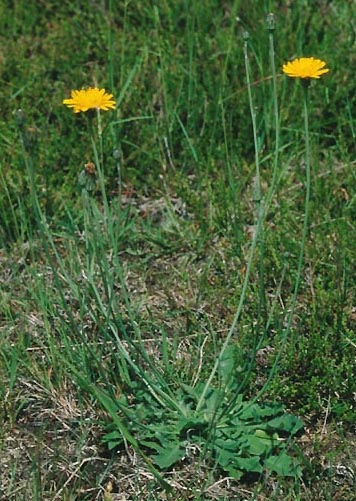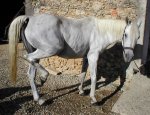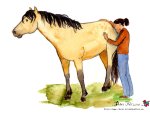
Flatweed (Hypochoeris radicata) is a perennial rosette-forming herb (a cluster of leaves at the base of a plant often lying flat against the ground), in Asteraceae family.
The rough-haired leaves are similar to the Dandelion ones. However they are thicker, less indented, with a rounder outline. Flowers are bright yellow and appear from may to august (and until november if the the weather stays mild).
You may encounter this plant on any kind of soil, unless the ground is too acidic. It is abondant on overgrazed grounds or when phosphorus and potassium concentration is low.
Intoxication is increased when drought and concerns horses grazing all year round.
Toxicity is not wellknown. The involvement of a mycotoxin was raised without it being formally identified.
During intoxication, the horse presents stringhalt, It means it has an involuntary hyperflexion of the hind limbs, bilaterally in the vast majority of cases.
This is known as "Australian stringhalt". Sometimes the movement is so important that the dorsal side of the shin touches the abdomen.
Usually amyotrophy as well as loss of weight are associated with the disease and sometimes respiratory difficulties (roaring horse) occur.

Concerning the lesional level, there is loss of large myelinated fibers in peroneal, distal tibial, plantar digital and recurrent laryngeal nerves, resulting in atrophy and fibrosis of the corresponding muscles.
No central nervous system injury was found, but the conduction of affected nerves is three times lower. This conduction defect affects both the motor axon as well as the neuromuscular junction.

The recovering to health is done spontaneously if the horse is subtracted from the offending meadows. It takes between 6 to 12 months (or more) to observe a remission. Allopathic treatments offered are rare.
It appears that phenytoin at 15 to 25 mg / kg orally, twice a day, provides good results. In severe cases, surgery is recommended. Tenectomy of the phalange lateral extensor on the affected limbs is then performed. Some surgeons even realise a myotenectomy, by removing a small distal portion of the lateral extensor muscle.
The presentation focuses on three horses with Australian Harper : two mares, a French Saddle one and an Arabian one, and a gelding spanish horse. These horses were grazing in the same meadow, on which the owner had spent a few days before the "girobroyeur" [1], while leaving the animals in the pasture (Flatweed is not spontaneously consumed by horses, but once cut and dried, it is no longer recognized). The Arabian mare, the more damage is immediately transported to a clinic to be operated. The other two are only treated by osteopathy.
During the osteopathic consultation, there is, in all cases, a very high MTF [2]. Regarding horses with less damages, the correction of this high MTF and after the regularization of the Helix in the fascia tissue (at the same time ) allowed a gradual return to normal health within 10 days. The Arabian mare was however much disability: she could move herself only at full gallop,then for stopping she had to make circles smaller and smaller. During stress, such as food distribution, the movement is still exaggerated. The surgery made no improvement.
After an initial osteopathic manipulation, she is able to stop without making circles and his canter is more runny. With a second manipulation, 15 days later, the mare is able to walk again without stringhalt and gallops like all Arabians, raised tail.
During the third visit, the MTF is still high, but much less than the first two consultations. Progress towards recovery are increasingly clear: after three sessions (so about 1.5 months after the first manipulation), the mare is able to of make U-turns without stringhalt, even under the effect of a stressful external agent. According to the owner, the improvements are daily.
Once again we see that the field of osteopathy is much broader than just resolution of locomotor problems. Certainly, in this type of poisoning there is spontaneous remission, but thanks to some manipulation, we can significantly shorten the healing time. This is especially interesting in this case where allopathic medicine is powerless.



